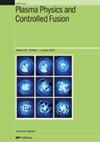用激光汤姆逊散射法观测无磁化级联弧氦等离子体中的低电子密度和电子温度
IF 2.3
2区 物理与天体物理
Q2 PHYSICS, FLUIDS & PLASMAS
引用次数: 0
摘要
在这项研究中,我们利用最先进的激光汤姆逊散射技术精确测量了非磁化级联弧形氦(He)等离子体中的电子密度(ne)和温度(Te)。在我们的实验范围内,ne仅为1018 m-3,Te小于0.2 eV,这两个值都大大低于线性等离子体设备(LPD)。将 He 等离子体中的 ne 值和 Te 值与级联弧 Ar 等离子体中的 ne 值和 Te 值进行比较后发现,He 等离子体中的这两个参数平均值也明显低于 Ar 等离子体。与 Ar 气体相比,He 的电离电位高,电离程度低,而且由于重量轻,扩散损耗占主导地位,这两个因素都导致 ne 值较低。同时,这两个特点使得 He 等离子体中电子和 He+ 离子之间的三体重组相互作用变得微不足道,因此电子不能被有效加热,这也是 Te 较低的原因。这项研究将提供基础数据,为全面了解低压差分放大器和等离子窗口中的级联电弧 He 等离子体奠定基础。本文章由计算机程序翻译,如有差异,请以英文原文为准。
Observation of the low electron density and electron temperature in an unmagnetized cascaded arc helium plasma by laser Thomson scattering approach
In this study, the electron density (ne
) and temperature (Te
) in an unmagnetized cascaded arc helium (He) plasma are precisely determined using cutting-edge laser Thomson scattering. In our experimental scope, ne
is only 1018 m−3 and Te
is less than 0.2 eV, both of which are substantially lower than in linear plasma devices (LPDs). The comparison of ne
and Te
values in He plasma with those in cascaded arc Ar plasma reveals that these two parameters are likewise significantly lower in He plasma than they are in Ar plasma on average. In comparison to Ar gas, the degree of ionization of He is low due to its high ionization potential, and diffusive loss dominates due to its light weight, both of which result in a lower ne
. Meanwhile, these two characteristics render the three-body recombination interaction between electrons and He+ ions in He plasma insignificant, thus the electrons cannot be heated effectively, explaining why Te
is lower. This study will provide foundational data and build the groundwork for a thorough knowledge of cascaded arc He plasma in LPDs and plasma windows.
求助全文
通过发布文献求助,成功后即可免费获取论文全文。
去求助
来源期刊

Plasma Physics and Controlled Fusion
物理-物理:核物理
CiteScore
4.50
自引率
13.60%
发文量
224
审稿时长
4.5 months
期刊介绍:
Plasma Physics and Controlled Fusion covers all aspects of the physics of hot, highly ionised plasmas. This includes results of current experimental and theoretical research on all aspects of the physics of high-temperature plasmas and of controlled nuclear fusion, including the basic phenomena in highly-ionised gases in the laboratory, in the ionosphere and in space, in magnetic-confinement and inertial-confinement fusion as well as related diagnostic methods.
Papers with a technological emphasis, for example in such topics as plasma control, fusion technology and diagnostics, are welcomed when the plasma physics is an integral part of the paper or when the technology is unique to plasma applications or new to the field of plasma physics. Papers on dusty plasma physics are welcome when there is a clear relevance to fusion.
 求助内容:
求助内容: 应助结果提醒方式:
应助结果提醒方式:


